It’s the video everyone’s watching: OK Go’s incredible zero gravity shoot for their single Upside Down & Inside Out, which takes their imagination and meticulous choreography to a whole new world. It blew our minds, too. Yes, we focus on news and documentary shooting. But sometimes you can’t help but be wowed by something outside your discipline – and there’s no better example than this.
Shooting in zero gravity places lots of constraints on the production crew and I wanted to find out exactly how they had created the video. So who better to talk to than the DP Evgeniy Ermolenko and the BTS cameraman Geoff Shelton?
Evgeniy Ermolenko – Director of Photography
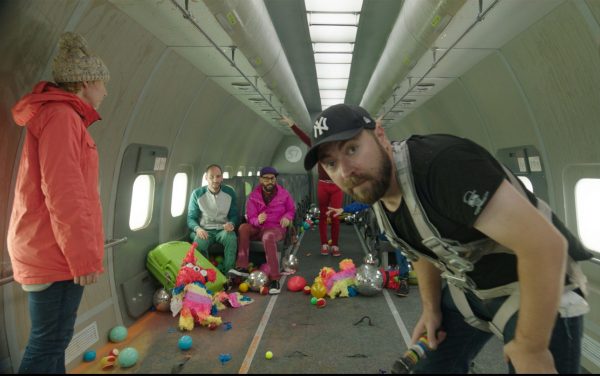
What was your reaction when you were first briefed about the concept?
When a director approaches me with a concept — any concept really — I can only react in one of the following ways:
1. Great! Let’s do this!
2. Great! Let’s find a way to do this!
As you can imagine, this time it was the latter. This job would have been a challenge for any DoP, regardless of their experience or level of expertise.
What cameras, lenses, lights and equipment were used?
It was not hard to choose the right gear for this project. We needed reliable, ‘fool-proof’ equipment that has stood the test of time — a kind of set-up that is used by professional DoPs regularly, every day, in any part of the world. The only limitation we had was the power — we had only 3 kW to spare for all pieces of equipment.
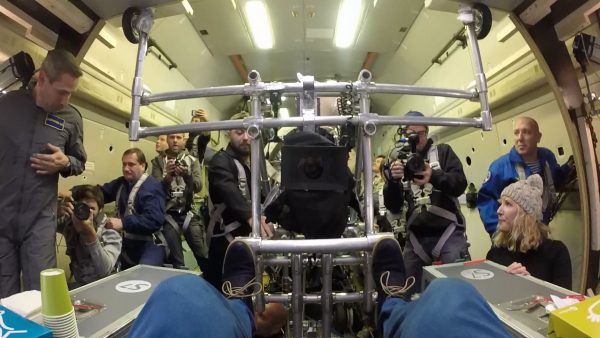
Camera: AlexaXT
Lens: UltraPrime 14 mm/T1.9
Sprayoff rain deflector
Light (we had a very modest lighting set-up): 30x panels 1×1 5600 BI-Focus, 8x Kinoflo 4×4
1x Telescopic Crane
Oh yes, the telescopic crane —
After the first 6 flights that we did (i.e. test flights), we realized that the picture desperately needed some motion. It just so happened that I had only wrapped up a production a week ago using a lightweight and very mobile telescopic crane, so I suggested we’d use it for this project as well. That’s how we became the first crew ever to use this kind of equipment in a zero gravity shoot.
What do you have to consider when shooting in zero gravity?
The biggest challenge was getting stable and controllable motion. This is something that is very hard to achieve in zero gravity. We needed to solve this quickly and for good, so that the directors could focus on the creative side of things.
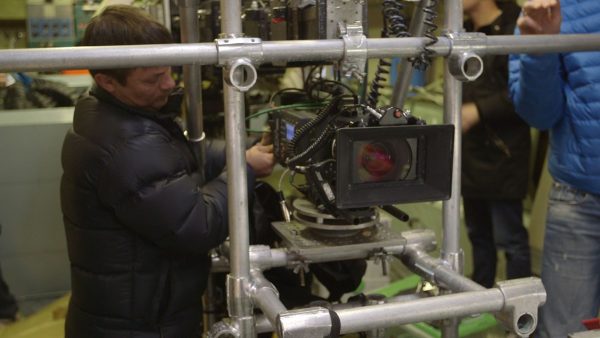
How much pre-production was required for the video?
The DoP’s pre-production consisted of collecting every piece of information related to zero gravity flights. The web has been a great help — I’ve found out that Vadim Yusov, the legendary Soviet DoP, shot a documentary in zero gravity. Watching his work increased my confidence a lot. It took us five days to set up the equipment for the initial test flights.
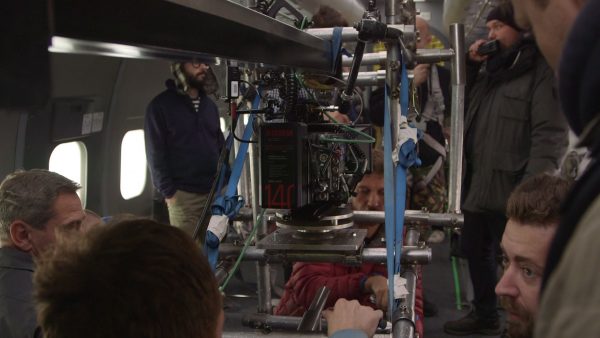
How much preparation was involved in making sure everything was securely locked down and wouldn’t move in zero gravity?
We started working on it after the first flight. It turned out that the the grip we were using for the camera was simply not enough in zero gravity — nobody told us, since we were the first crew to use a telescopic crane in this environment. It took us 10 flights to be 95% locked down and ready — five of them to tinker with the crane alone.
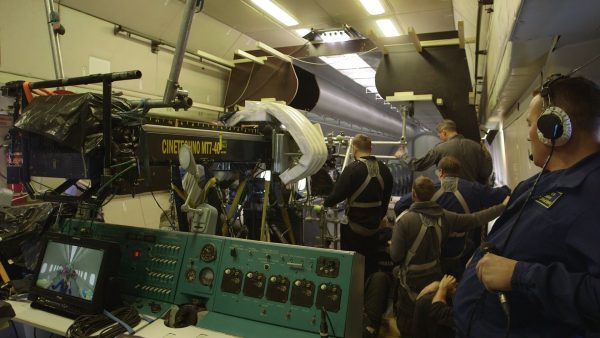
What was the biggest challenge in shooting the music video?
First, stabilizing the jib arm of the crane. We used the arm guide as the restrictor and also for support. Initially we wanted to use tracks, but discarded the idea. The choreography was centered inside the main aisle and placing tracks there could have hurt the actors if they fell on them. As a result, we made a construction with two lower and two upper rest arms. By changing pressure inside the wheels, we reduced the shaking of the jib arm by 10-15x. I believe it couldn’t move more than by one centimeter tops in any direction after that.
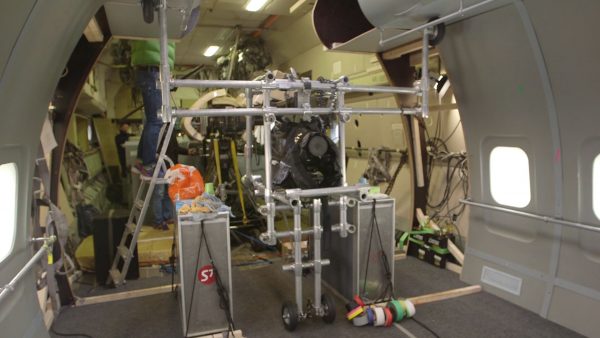
Second, safety. I place safety above everything else, so we fixed all pieces of the crane in place in such a way that it wouldn’t cause or aggravate any emergency situation on the plane. We also needed to bear in mind while building the supporting construction that it couldn’t weigh more than 25 kilograms (55 lbs). The double gravity periods that were experienced 30 times during the flight made everything twice as heavy, which could have damaged the jib arm, endanger the production, and safety of others.
Were you happy with the end result?
Yes! 48 million views say this better than anything else. But the most important end result for me was meeting new colleagues who became dear friends to me in the process.
Geoff Shelton – Documentarian/BTS
How did you originally become involved with the project?
I was hired in Dec 2012 to document OK Go record their new album Hungry Ghosts. Since that project I was brought on to document the creation of their music video Writing’s on the Wall. So we’ve had an established working relationship for a few years now and the band and I have developed a good rapport.
What was your initial reaction when you first heard about the concept behind the music video?
Damian told me about this idea when I was shooting them recording their album. It’s an idea that he and his sister/co-director Trish Sie have been wanting to do for a number of years now. When he told me about it then, it sounded like the most amazing concept I had heard. Before then I did not know that parabolic flight existed. When the band contacted me this past August to tell me that this project was actually going to happen, I didn’t believe it. I think it is safe to say that pretty much everyone involved in the project did not believe it was actually going to happen until we found ourselves looking at the plane on an airstrip outside of Moscow.
Where was the music video filmed and how much pre production was required for the video?
The video was filmed outside of Moscow on an airstrip used for government purposes only. The plane is an Ilyushin IL-76 and is owned by Roscosmos (the Russian equivalent to NASA). It is used to train Astronauts/Cosmonauts how to move and operate in zero-G conditions.
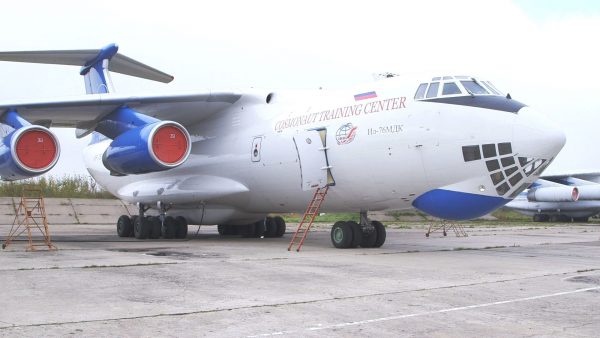
Can you explain how the aircraft is able to generate zero gravity, what it feels like and how short a period of time the plane can do it for?
Once the plane reaches about 6000 meters it begins a flight pattern called a parabola. Which in simple terms is basically the shape of a hill. So the plane points itself upward at a very steep angle and accelerates about 3000 meters in about 20 seconds. During that time, all of us in the plane experience the feeling of double gravity due to the speed of acceleration against the gravitational force of the earth. At the peak of the hill the plane brings the nose back down as it goes over the ‘hill’. At this point everyone is lifted into the air just as you would if going over a bump in the road very fast or going over the top of a roller coaster, only in this case you stay in the air. At this point the plane accelerates toward the ground against the air current as you are essentially falling together with the plane. But because you are falling in this pressurized closed environment, relatively, you experience the feeling of zero gravity for about 27 sec. As the plane reaches the bottom of the parabola, it pulls itself out of this dive and levels its nose out again, essentially catching you. During this final part of the maneuver you experience another 20 sec or so of double gravity. After the parabola it takes the plane about 4 to 7 minutes to reach the altitude and air space to repeat this pattern. Over the course of each flight we would do 15 of these parabolas.
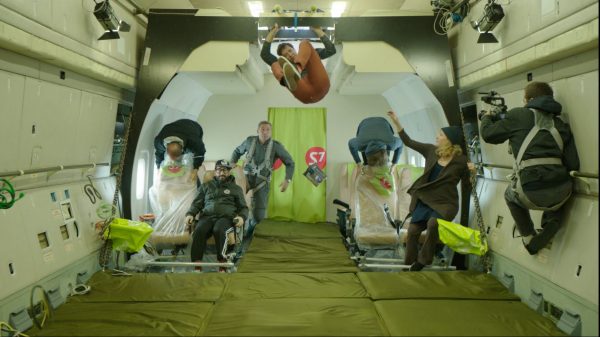
Can you describe how difficult it is to shoot in zero gravity?
As you might guess, it is extremely hard to shoot in these conditions. First challenge is just to see if you can stomach it. Luckily, with one pill of Bonine per flight, I did fine. We definitely had several other potential crew members that just couldn’t physically take it (they were puking their guts out). As a shooter, the challenge is even worse because they tell you one of the worst things you can do in these conditions is to focus on a small screen in front of you.
Once you get past the sickness factor the main challenge for myself as a doc shooter is figuring out how to cover everything with interesting shots that are not completely shaky. Not only are you dealing with double gravity and zero gravity but when there’s regular gravity, you’re still in a plane that has a general amount of turbulence. All types of stability rigs that you could think of are dependent upon gravity in order to function.
I did a few flights where I started out on a tripod that we strapped to the ground. With a tripod your main challenge is just to keep yourself from flying away when zero-G hits so I would grab on to bars on the wall and wrap a foot in to a strap on the ground. But the tripod option was too limiting. In our first week of flights the band, directors and aerialists were trying to figure out what choreography was possible, whether or not they could figure out a camera move and what types of props and liquids could be used. So at times there would be activity toward the front of the plane with the aerialists practicing moves in a large open space, the band were toward the back of the plane in a test set and then the Prop Master was in the very back of the plane, that was completely covered in plastic sheeting, just spraying different types of liquids, gels and popping balloons of water, milk and paint. I had to be able to move.
Once the set was in place by week 2, the amount of space I had to capture everything was very tight, there were lots of people, the floor was covered with 3 inches of foam padding and the main camera rig dominated the space in front of me.
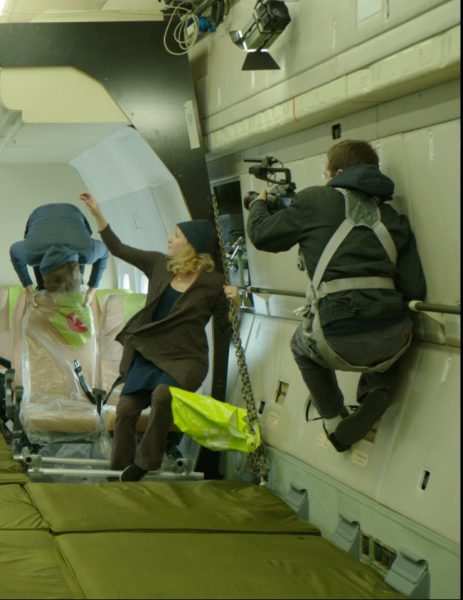
I would either go completely hand-held or some times use a Manfrotto monopod. The monopod was helpful to maintain steadier shots when there was regular gravity in between parabolas and I was generally able to maintain a shot once double gravity came on, though sometimes the force of double gravity would also make my rig shake even with the monopod. Double gravity actually broke the shock mount I had my shotgun mic on at one point. When the zero gravity lift would come, I would try to hold on to something structural to keep myself in place. During zero-G I would keep myself wedged in or arm/foot locked around something so my hands could be free to adjust zoom and focus. Then when double gravity would return, if I had my monopod, I could hopefully help it set back down without too much of a bang. If I was handheld it was basically impossible for the camera not to shake.
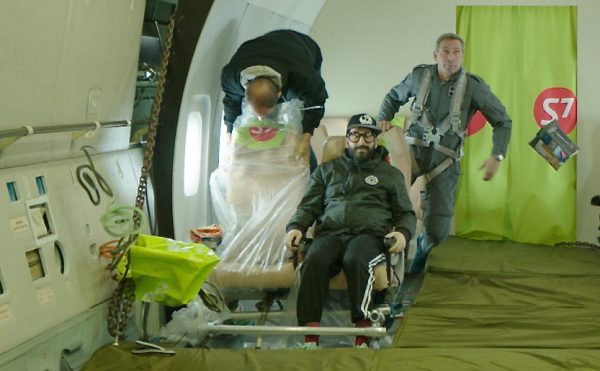
The other amazing and most useful way I was able to get shots was working with our Cosmonaut trainers. The trainers from the Yuri Gagarin Research and Test Cosmonaut Training Center were with us through the whole experience of making the video and were not only integral for us to learn how to physically operate in this environment, but eventually became key to all of the choreography off-camera as well. For myself personally, I would wear a parachute harness during each flight and would communicate with the trainers in a little English, my broken Russian and lots of hand signals to tell them what I wanted to do during the parabola. They would then brace themselves into position and grab on to my harness to help with whatever camera move I wanted to do. If I wanted to float up to get a shot from above they would help me glide up slowly and then hold me there. As the parabola ended they would slowly glide me back down. They were my heroes.
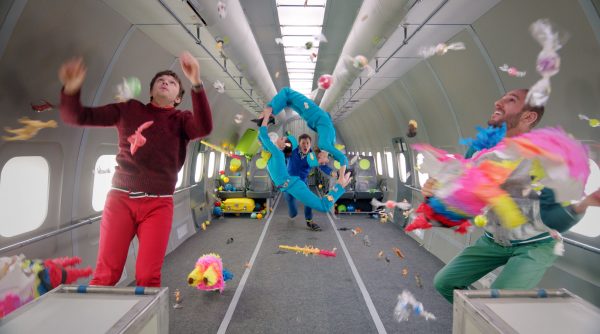 Photo: Geoff Shelton and OK Go
Photo: Geoff Shelton and OK Go
How many takes and flights did it take to get all the neccessary shots?
After the test week, the directors came up with a plan to shoot the video in 8 scenes. They would perform a scene during a parabola, then freeze in position in between parabolas, then perform the next scene when zero-G hit again. The goal was to get through all eight scenes consecutively so the post-prod team could stitch all eight parabolas together without a lot of discontinuity between the props in the shot. With 15 parabolas per flight, the main pattern during shoot week was that they would shoot the first seven scenes of the music video in the first seven parabolas. This left out the last scene with all of the paint balloons. Then everyone would scramble to re-set everything. Then they would perform the whole video straight through for the last eight parabolas of the flight. We all did 21 flights total over three weeks. The last week was shoot week and we were scheduled to do two flights per day on Mon, Tues, Thurs and Fri.
On Thursday, one of the flights was grounded after only three parabolas due to a blown fuse with the production equipment. As a result, on the last day, the crew was offered a third flight. By the last day they had many good takes of each scene but nothing great consecutively. During the second flight of the last day they got through a seemingly perfect take of every scene and assumed they were done. Upon review of the footage, they found that in the last scene, paint from one of the balloons had fogged the lens. So they agreed to do the final flight, of only eight parabolas. During that final flight they nailed everything and that became the music video. So if you only count shoot week, there were 8 1/5 flights and essentially 1 7/8 of the whole video per flight.
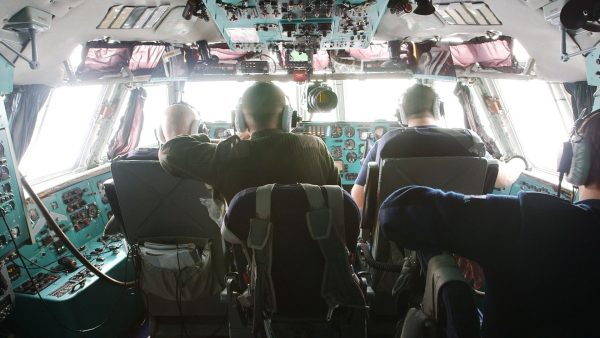
What were the biggest challenges the production faced?
One basic challenge was the natural amount of things that get lost in translation even with a couple great interpreters between the American band, directors and one American producer with an all Russian crew, Russian Cosmonaut trainer team, Russian sponsor and Russian ad agency. Its hard enough getting all the info straight through that many channels when everyone speaks the same language. Luckily, everyone was so professional and hard working that they were able to work through this well.
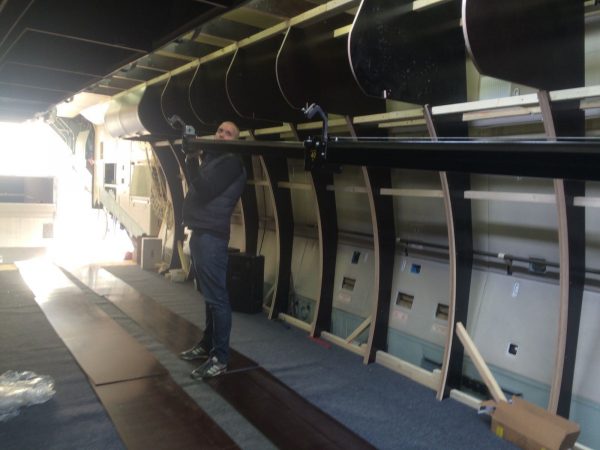 Photo: Geoff Shelton and OK Go
Photo: Geoff Shelton and OK Go
From my outside perspective as a doc shooter on the project following the action, I’d say the biggest general challenge for everyone was the conflict between trying to do something that was very precise within the inherent unpredictability and extremely physically challenging nature that is the parabolic flight.
The exact timing of the amount of time in zero-G is never completely perfect. The 27 sec of zero-G is an average that is variable by a second or two depending on a number of aviation factors. The zero-G experience itself for us within the plane is always variable because it is always in relation to how the position of the plane is affected by the air currents outside. For instance, if the wind is such that it moves the plane up or down then your position in the air within the plane, is relatively adjusted. In plainer words: if the plane is nudged to the right, then you go left. So to try and do repeatable and specific choreography within and outside of the frame, was at times very difficult.
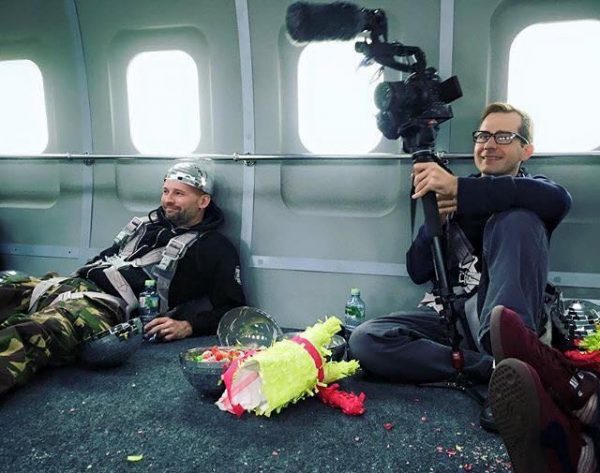
Photo: Damian Kulash
Aside from that, the experience of doing these flights is just very hard on the body. After the flights everyone would feel very exhausted and in general just off. If you’re familiar with that feeling you get after being in the ups and downs of waves in the ocean for a while, where you get out and still feel like your floating in the water, multiply that feeling by 10. Then try to take care of all the production work you still have to do to prepare for the next shoot.
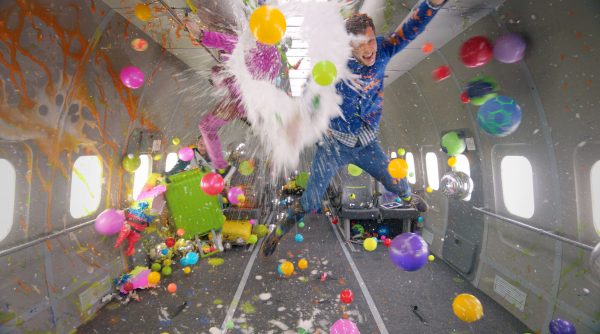
What was the liquid in the balloons that got popped? Did the plane have to be cleaned after every take?
Non-toxic paint that I believe was watered down a bit. The plane was cleaned after every flight by an amazing crew that would pick everything up, wipe everything down and vacuum the whole set in time for us to be ready to shoot again just a few hours later.
Finally can you sum up your over all experience of being part of the production crew?
Being on the production was equally exhilarating and exhausting, but my take-away was one of inspiration and awe. All of these amazing people came together speaking different languages from two very different cultures, across multiple different industries, and put themselves through extremely difficult conditions to execute these ingenious artistic ideas of directors Trish Sie and Damian Kulash. And basically all of that happened just to put a smile on your face. If that doesn’t open your heart to the power of the human spirit and the magic of this visual medium we work in, I don’t know what would…
All photos and video courtesy of Geoff Shelton, Trish Sie, OK Go, Damian Kulash, and Evgeniy Ermolenko. Do not reproduce without their written consent.





